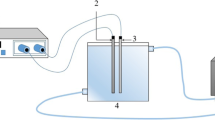Abstract
A membrane bioreactor has been used to treat an industrially produced waste-water containing aniline, 4-chloroaniline, 2,3-dichloroaniline and 3,4-dichloroaniline. Conventional direct biological treatment of such effluents cannot be implemented without some form of pretreatment or dilution because of the hostile inorganic composition of the waste-water. In order to overcome this problem a membrane separation step selectively removes the organics from the waste-water and subsequent biodegradation takes place in the biological growth compartment of the reactor system. At a waste-water flow rate of 69 ml h−1 (corresponding to a contact time of approximately 1.5 h) over 99% of the organic compounds quoted above were removed and biodegraded.
Similar content being viewed by others
References
Atlas RM (1983) Limitations to microbial of environmental pollutants. In: Alexander M (ed) Microbial technologies to overcome environmental problems of persistent pollutants. Expert group Meeting on microbial technologies to overcome environmental problems of persistent pollutants, Nairobi: United Nations Environment Programme, 1987, pp 39–46
Bretscher H (1981) Waste disposal in the chemical industry. In: Leisinger T, Hütter R, Cook AM, Nüesch J (eds) Microbial degradation of xenobiotics and recalcitrant compounds. Academic Press, London, pp 65–74
Cho C-W, Hwang S-T (1991) Continuous membrane fermentor separator for ethanol fermentation. J Membr Sci 57:21–42
Dommez MP (1986) Study of the discharge of certain dangerous substances into the aquatic environment and the best technical means for the reduction of water pollution from such discharges in application of the directive 76/464/CEE. Report carried out for the European Economic Community under contract no. 85/B/6600/11/003/11/M, Excoser, Brussels
European Economic Community (EEC) (1982) Communication from the Commission to the council on dangerous substances which might be included in List I of Council Directive 76/464/ECC, Brussels
Finn RK (1983) Use of specialized microbial strains in the treatment of industrial waste and in soil decontamination. Experientia (Basel) 39:1231
Hogrefe W, Grossenbacher H, Cook AM, Hütter M (1984) Biotreatment of s-triazine-containing wastewater in a fluidized bed reactor. Biotechnol Bioeng 28:1291–1296
Iwasaki I, Utsumi S, Hagino K, Ozawa T (1956) A spectrophotometric method for the determination of small amounts of chloride using the mecuric thiocyanate method. J Chem Soc Jpn 29:860–864
Lide DR (1991) Handbook of chemistry and physics, 71st edn. CRC Press, Baco Raton, Fla.
Livingston AG (1991) Biodegradation of 3,4-dichloroaniline in a fluidized bed bioreactor and a steady-state biofilm kinetic model. Biotechnol Bioeng 38:260–272
Livingston AG, Willacy A (1991) Degradation of 3,4-dichloroaniline in synthetic and industrially produced waste-waters by mixed cultures freely suspended and immobilized in a packed-bed reactor. Appl Microbiol Biotechnol 35:551–557
Nguyen TQ, Nobe K (1987) Extraction of organic contaminants in aqueous solutions by pervaporation. J Membr Sci 36:373–384
Perry RH, Green DW (1984) Chemical engineers handbook. McGraw-Hill, New York
Prasad R, Sirkar KK (1988) Dispersion-free solvent extraction with microporous hollow-fiber modules. AIChEJ 34:177–188
Wagner K, Hempel DC (1988) Biodegradation by immobilized bacteria in an airlift-loop reactor. Biotechnol Bioeng 31:559–566
Watson JM, Payne PA (1990) A study of organic compound pervaporation through silicone rubber. J Membr Sci 49:171–205
Westmeier F, Rehm HJ (1987) Degradation of 4-chlorophenol in municipal waste-water by adsorptive immobilized Alcaligenes. Appl Microbiol Biotechnol 26:78–83
Wheatley AD (1974) Biotechnology and Effluent Treatment. In: Russell GE (ed) Biotechnology and genetic engineering reviews. Intercept, Newcastle-upon-Tyne, pp 261–310
You IS, Bartha R (1982) Stimulation of 3,4-dichloroaniline mineralization by aniline. Appl Environ Microbiol 44:678–681
Zander AK, Chen JS, Semmens MJ (1991) Removal of hexachlorohexane isomers from water by membrane extraction into oil. Water Res 26:129–137
Zhu CL, Yuang CW, Fried JR, Greenberg DB (1983) Pervaporation membranes — a novel separation technique for trace organics. Environ Prog 2:131–142
Author information
Authors and Affiliations
Additional information
Correspondence to: A. G. Livingston
Rights and permissions
About this article
Cite this article
Brookes, P.R., Livingston, A.G. Point source detoxification of an industrially produced 3,4-dichloroaniline-manufacture wastewater using a membrane bioreactor. Appl Microbiol Biotechnol 39, 764–771 (1993). https://doi.org/10.1007/BF00164464
Received:
Accepted:
Issue Date:
DOI: https://doi.org/10.1007/BF00164464




